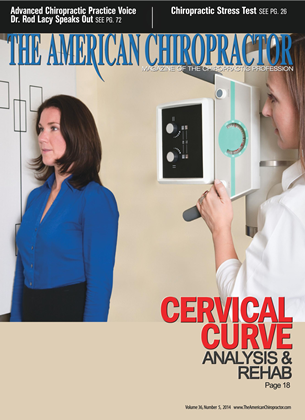Have you ever been explaining something to a patient when, 20 seconds into your explanation, you see the "deer in the headlights" look? You just know the patient is hearing the teacher from Peanuts saying. "Whant whant . . . whant whant wha. " When I see this look, it is my cue to close my mouth and start thinking of a different way to get my point across. People learn in main different ways. Some learn better by listening (auditory), seeing (visual), or doing, or even through a combination of some or all. For those of us who teach posture or corrective exercise. Birdwhistcll1 discovered that kincsthctic guidance (teaching someone through touching and moving) could translate to changes in behavior 30 times faster than visual guidance, and thousands of times faster than auditor* instruction alone. If I want someone to move better, having them feel what the proper movement should be like will result in faster learning and quicker results. The same can be tnic for teaching someone what proper posture feels like. Improving posture is important because loss of ideal posture can be the core of main pain syndromes, headaches, and joint and muscle pain. Poor posture can lead to both acute and chronic injuries. For me to teach proper posture. I like to put my patients in the proper posture and then give them some feedback cues for how to maintain that posture. I then groove tliat new posture with progressive resistance exercises. My favorite postural feedback cue is the use of kincsiology tape (K-tape). Using kincsiology tape is an excellent adjunct in the rehabilitation phase of making postural improvements. The tape gives feedback to patients if they arc coming of posture and alerts them to self-correct. If you arc using good, quality kine-siology tape, that effect can last up to five days. Five straight days of getting feedback and doing corrective exercises has been a huge success in my clinic. There arc different methods of teaching postural taping, and I use a very simple approach. Some people teach to exaggerate posture and then put a lot of stretch on the tape. This type of taping forces the body into this new position. I do not teach this method. I find that if you force the position, it is too uncomfortable, and then patient compliance is poor. I might as well use an uncomfortable posture brace if I am going to force the position. The benefits of kincsiology tape is giving neurosensory (afferent) feedback to the brain and allow ing for full range of motion. I take this approach to taping for posture correction: Place patients in a position where if they close their eyes, they do not have any muscular contribution to the position. Tape the body in this position with no stretch on the tape. The person will get small sensory input if he or she falls out of the position. Give your favorite exercises to groove this pattern. Having the patient in the proper posture prior to the exercise will benefit the exercises as well. When I teach students this method, a common mistake I see is to overcorrcct from the beginning, which can be uncomfortable for the patient. Sometimes if a patient's posture is really poor. I will make small corrections over time. Patients will be a lot more compliant when they are comfortable. In addition to teaching patients proper static positions (i.e.. standing and sitting), it is important to expand your idea about how posture or position relates to movement. Thcdon's2 study on degradation of posture due to muscle fatigue showed that simply using a small piece of tape on the Achilles' tendon was enough stimulation to improve quiet standing posture for fatigued individuals. The study concluded that "when the muscular sensory input flow normally relevant for the postural system is impaired due to fatigue, the weight of cutaneous information increases for the successful representation of movements in space to adjust postural control." In other words, as the subjects became fatigued, their postural stability depended to a greater degree on the information coming to the brain from the skin. Another study on children with cerebral palsy showed positive changes and sitting posture (head, neck and foot positions, as well as arm and hand function), concluding that in clinical settings kincsiology tape may be a beneficial assistivc treatment approach when combined with pin sical therapy. An example of taping for movement is when I have a runner who externally rotates his or her foot when walking or running. Even just a few degrees of external rotation can increase risk for injury (especially medial knee pain) and reduces stride length (decreasing performance). I will place the runner's foot as close to neutral as I can (without restricting range of motion) and then tape it in that position for better foot strike. In conclusion, instead of just telling your patients to "stand up straight." consider taping them into a position that you want them to be in. Tape will help reinforce this proper posture quickly and you" 11 get better results with your treatment. References: Birdwhistcll R. 1970. Kinesics and C 'onlexl. University of Pennsylvania Press. Phila delphia. Thcdon T. ct al. Degraded postural performance after muscle fatigue can be compensated by skin stimulation. Gait & Posture. 2011: 33:686-689. Simsek TT. ct al. The effects of kincsio taping on sitting posture, functional indepen dence and gross motor function in children with cerebral palsy. Disability and Reha bilitation. 2011: 33(21-22):2058-2063. Ed Le Cara, DC, PhD, ATC, CSCS is board certified in sports medicine and rehabilitation. He is a chiropractic clinician, educator and on the medical advisory board for Rocktape. He provides live and online education for movement professionals at www.Healthandnellnessl'roviders.com. To contact him. email at drlecaraciSporlsPhisBayArca.com or follow on Twiller: adrlecara. He hosts a monthly wehinar demonstrating different taping applications and answers questions. Look on Google Hangouts under 'Basics ofKinesiology Taping' for his next event.
 View Full Issue
View Full Issue









